Research Status and Potential Direction for Thermoplastic Shape Memory Polymers and Composites: A Review
Abstract
1. Introduction
2. Thermoplastic SMPs
3. Mechanism
4. SMPs Matrix Polymers
5. Diverse Stimuli Actuations
5.1. Electrical Actuation
5.2. Magnetic Actuation
5.3. Light Actuation
5.4. Solvent Actuation
6. Applications
6.1. Biomedical Stents
6.2. Flexible Electronics
6.3. Smart Actuators
6.4. Engineering Structures
7. Future Directions
7.1. Four-Dimensional Printing Metamaterial
7.2. Dynamic Covalent Networks
8. Conclusions
Author Contributions
Funding
Institutional Review Board Statement
Conflicts of Interest
References
- Yang, L.D.; Lou, J.K.; Yuan, J.M.; Deng, J.R. A review of shape memory polymers based on the intrinsic structures of their responsive switches. RSC Adv. 2021, 11, 28838–28850. [Google Scholar] [CrossRef] [PubMed]
- Xie, T. Recent advances in polymer shape memory. Polymer 2011, 52, 4985–5000. [Google Scholar] [CrossRef]
- Bai, X.; Yang, Q.; Fang, Y.; Yong, J.L.; Bai, Y.K.; Zhang, J.W.; Hou, X.; Chen, F. Anisotropic, adhesion-switchable, and thermal-responsive superhydrophobicity on the femtosecond laser-structured shape-memory polymer for droplet manipulation. Chem. Eng. J. 2020, 400, 125930. [Google Scholar] [CrossRef]
- Yan, H.H.; Li, L.L.; Shi, X.C.; Yeh, J.; Wei, Y.; Zhang, P.Z. Conductive stretchable shape memory elastomers combining with electrical stimulation for synergistic osteogenic differentiation. Polym. Test. 2020, 90, 106672. [Google Scholar] [CrossRef]
- Alanagh, H.R.; Akbari, B.; Imani, A.; Zhang, Y.D.; Gao, X.Q. Diffusion of poly (l-lactide) in activated metal organic frameworks; crystallization evidenced by ssNMR and subsequent shape memory effects. Polym. Test. 2020, 90, 106726. [Google Scholar] [CrossRef]
- Antony, G.J.M.; Aruna, S.R.S.T.; Jarali, C.S. Effect of the addition of diurethane dimethacrylate on the chemical and mechanical properties of tBA-PEGDMA acrylate based shape memory polymer network. J. Mech. Behav. Biomed. 2020, 110, 103951. [Google Scholar]
- Zhang, Y.C.; Desai, M.S.; Wang, T.; Lee, S. Elastin-Based Thermoresponsive Shape-Memory Hydrogels. Biomacromolecules 2020, 21, 1149–1156. [Google Scholar] [CrossRef]
- Ji, F.C.; Liu, X.D.; Sheng, D.K.; Yang, Y.M. Epoxy-vitrimer composites based on exchangeable aromatic disulfide bonds: Reprocessibility, adhesive, multi-shape memory effect. Polymer 2020, 197, 122514. [Google Scholar] [CrossRef]
- Zheng, Y.; Zeng, B.B.; Yang, L.H.; Shen, J.B.; Guo, S.Y. Fabrication of Thermoplastic Polyurethane/Polycaprolactone Multilayered Composites with Confined Distribution of MWCNTs for Achieving Tunable Thermo- and Electro-Responsive Shape-Memory Performances. Ind. Eng. Chem. Res. 2020, 59, 2977–2987. [Google Scholar] [CrossRef]
- Wang, W.; Liao, X.; Guo, F.M.; Wang, G.; Yan, Z.H.; Liu, F.; Li, G.X. Facile Fabrication of Lightweight Shape Memory Thermoplastic Polyurethane/Polylactide Foams by Supercritical Carbon Dioxide Foaming. Ind. Eng. Chem. Res. 2020, 59, 7611–7623. [Google Scholar] [CrossRef]
- Wu, J.Q.; Yu, X.; Zhang, H.; Guo, J.B.; Hu, J.; Li, M.H. Fully Biobased Vitrimers from Glycyrrhizic Acid and Soybean Oil for Self-Healing, Shape Memory, Weldable, and Recyclable Materials. ACS Sustain. Chem. Eng. 2020, 8, 6479–6487. [Google Scholar] [CrossRef]
- Iregui, A.; Otaegi, I.; Arandia, I.; Martin, M.D.; Müller, A.J.; Irusta, L.; González, A. Fully Reversible Spherulitic Morphology in Cationically Photopolymerized DGEBA/PCL Shape-Memory Blends. Macromolecules 2020, 53, 1368–1379. [Google Scholar] [CrossRef]
- Cao, X.; Liu, H.Z.; Yang, X.H.; Tian, J.H.; Luo, B.H.; Liu, M.X. Halloysite nanotubes@polydopamine reinforced polyacrylamide-gelatin hydrogels with NIR light triggered shape memory and self-healing capability. Compos. Sci. Technol. 2020, 191, 108071. [Google Scholar] [CrossRef]
- Luo, F.B.; Yan, P.P.; Qian, Q.R.; Li, H.Z.; Huang, B.Q.; Chen, Q.H.; Wu, K.; Lu, M.G. Highly thermally conductive phase change composites for thermal energy storage featuring shape memory. Compos. Part A-Appl. S. 2020, 129, 105706. [Google Scholar] [CrossRef]
- Yan, J.; Li, M.F.; Wang, Z.W.; Chen, C.; Ma, C.Q.; Yang, G. Highly tough, multi-stimuli-responsive, and fast self-healing supramolecular networks toward strain sensor application. Chem. Eng. J. 2020, 389, 123468. [Google Scholar] [CrossRef]
- Vitola, V.; Bite, I.; Apsite, I.; Zolotarjovs, A.; Biswas, A. CuS/polyurethane composite appropriate for 4D printing. J. Polym. Res. 2021, 28, 13. [Google Scholar] [CrossRef]
- Debnath, S.; Tiwary, S.K.; Ojha, U. Dynamic Carboxylate Linkage Based Reprocessable and Self-Healable Segmented Polyurethane Vitrimers Displaying Creep Resistance Behavior and Triple Shape Memory Ability. ACS Appl. Polym. Mater. 2021, 3, 2166–2177. [Google Scholar] [CrossRef]
- Lv, H.T.; Tang, D.Y.; Sun, Z.J.; Gao, J.R.; Yang, X.; Jia, S.Y.; Peng, J. Electrospun PCL-based polyurethane/HA microfibers as drug carrier of dexamethasone with enhanced biodegradability and shape memory performances. Colloid Polym. Sci. 2020, 298, 103–111. [Google Scholar] [CrossRef]
- Wan, X.; Wei, H.Q.; Zhang, F.H.; Liu, Y.J.; Leng, J.S. 3D printing of shape memory poly(d,l-lactide-co-trimethylene carbonate). J. Appl. Polym. Sci. 2019, 136, 48177. [Google Scholar] [CrossRef]
- Ren, Y.J.; Zhang, Z.Z.; Xia, W.L.; Zhou, Q.F.; Song, X.F. Water-responsive shape memory PLLA via incorporating PCL-(PMVS-s-PAA)-PCL-PTMG-PCL-(PMVS-s-PAA)-PCL. Eur. Polym. J. 2021, 147, 110252. [Google Scholar] [CrossRef]
- Zhou, Y.Y.; Zhou, D.; Cao, P.R.; Zhang, X.R.; Wang, Q.H.; Wang, T.M.; Li, Z.L.; He, W.Y.; Ju, J.P.; Zhang, Y.M. 4D Printing of Shape Memory Vascular Stent Based on βCD-g-Polycaprolactone. Macromol. Rapid Comm. 2021, 42, 2100176. [Google Scholar] [CrossRef] [PubMed]
- Kausar, A. Shape memory polystyrene-based nanocomposite: Present status and future opportunities. J. Macromol. Sci. A 2021, 58, 182–191. [Google Scholar] [CrossRef]
- Zi, Y.C.; Pei, D.X.; Wang, J.H.; Qi, S.L.; Tian, G.F.; Wu, D.Z. High-Temperature-Induced Shape Memory Copolyimide. Polymers 2021, 13, 3222. [Google Scholar] [CrossRef] [PubMed]
- Ouyang, Y.T.; Zhang, Q.; Liu, X.K.; Hong, R.; Xu, X.; Lu, S.R.; Li, Y.Q. Effects of ionic liquid types on the tribological, mechanical, and thermal properties of ionic liquid modified graphene/polyimide shape memory composites. High Perform. Polym. 2021, 33, 881–891. [Google Scholar] [CrossRef]
- Wang, W.Y.; Lu, W.; Goodwin, A.; Wang, H.Q.; Yin, P.C.; Kang, N.G.; Hong, K.L.; Mays, J.W. Recent advances in thermoplastic elastomers from living polymerizations: Macromolecular architectures and supramolecular chemistry. Prog. Polym. Sci. 2019, 95, 1–31. [Google Scholar] [CrossRef]
- Zhao, Q.; Qi, H.J.; Xie, T. Recent progress in shape memory polymer: New behavior, enabling materials, and mechanistic understanding. Prog. Polym. Sci. 2015, 49–50, 79–120. [Google Scholar] [CrossRef]
- Chen, S.Y.; Zhang, Q.L.; Feng, J.C. 3D printing of tunable shape memory polymer blends. J. Mater. Chem. C 2017, 5, 8361–8365. [Google Scholar] [CrossRef]
- Zhang, Y.; Huang, L.M.; Song, H.J.; Ni, C.J.; Wu, J.J.; Zhao, Q.; Xie, T. 4D Printing of a Digital Shape Memory Polymer with Tunable High Performance. ACS Appl. Mater. Interfaces 2019, 11, 32408–32413. [Google Scholar] [CrossRef]
- Han, Y.L.; Yuan, X.H.; Zhu, M.Y.; Li, S.J.; Whitcombe, M.J.; Piletsky, S.A. A Catalytic and Shape-Memory Polymer Reactor. Adv. Funct. Mater. 2014, 24, 4996–5001. [Google Scholar] [CrossRef]
- Müller, K.; Zollfrank, C.; Schmid, M. Natural Polymers from Biomass Resources as Feedstocks for Thermoplastic Materials. Macromol. Mater. Eng. 2019, 304, 1800760. [Google Scholar] [CrossRef]
- Atmakuri, A.; Palevicius, A.; Vilkauskas, A.; Janusas, G. Review of Hybrid Fiber Based Composites with Nano Particles-Material Properties and Applications. Polymers 2020, 12, 2088. [Google Scholar] [CrossRef]
- Leng, J.S.; Lan, X.; Liu, Y.J.; Du, S.Y. Shape-memory polymers and their composites: Stimulus methods and applications. Prog. Mater. Sci. 2011, 56, 1077–1135. [Google Scholar] [CrossRef]
- Xia, D.Y.; Wang, P.; Ji, X.F.; Khashab, N.M.; Sessler, J.L.; Huang, F.H. Functional Supramolecular Polymeric Networks: The Marriage of Covalent Polymers and Macrocycle-Based Host-Guest Interactions. Chem. Rev. 2020, 120, 6070–6123. [Google Scholar] [CrossRef] [PubMed]
- Chen, T.Q.; Fang, L.; Li, X.; Gao, D.S.; Lu, C.H.; Xu, Z.Z. Self-healing polymer coatings of polyurea-urethane/epoxy blends with reversible and dynamic bonds. Prog. Org. Coat. 2020, 147, 105876. [Google Scholar] [CrossRef]
- Liu, P.C.; Lai, H.; Luo, X.; Xia, Q.X.; Zhang, D.J.; Cheng, Z.J.; Liu, Y.Y.; Jiang, L. Superlyophilic Shape Memory Porous Sponge for Smart Liquid Permeation. ACS Nano. 2020, 14, 14047–14056. [Google Scholar] [CrossRef] [PubMed]
- Bhattacharya, S.; Hailstone, R.; Lewis, C.L. Thermoplastic Blend Exhibiting Shape Memory-Assisted Self-Healing Functionality. ACS Appl. Mater. Interfaces 2020, 12, 46733–46742. [Google Scholar] [CrossRef] [PubMed]
- Li, G.; Wang, S.W.; Liu, Z.T.; Liu, Z.W.; Xia, H.S.; Zhang, C.; Lu, X.L.; Jiang, J.Q.; Zhao, Y. 2D-to-3D Shape Transformation of Room-Temperature-Programmable Shape-Memory Polymers through Selective Suppression of Strain Relaxation. ACS Appl. Mater. Interfaces 2018, 10, 40189–40197. [Google Scholar] [CrossRef]
- Wong, J.F.; Chan, J.X.; Hassan, A.; Mohamad, Z.; Othman, N. Thermal and flammability properties of wollastonitefilled thermoplastic composites: A review. J. Mater. Sci. 2021, 56, 8911–8950. [Google Scholar] [CrossRef]
- Zhang, Z.X.; Wang, W.Y.; Yang, J.H.; Zhang, N.; Huang, T.; Wang, Y. Excellent Electroactive Shape Memory Performance of EVA/PCL/CNT Blend Composites with Selectively Localized CNTs. J. Phys. Chem. C 2016, 120, 22793–22802. [Google Scholar] [CrossRef]
- Wang, K.J.; Jia, Y.G.; Zhao, C.Z.; Zhu, X.X. Multiple and two-way reversible shape memory polymers: Design strategies and applications. Prog. Mater. Sci. 2019, 105, 100572. [Google Scholar] [CrossRef]
- Yu, K.; Xie, T.; Leng, J.S.; Ding, Y.F. Mechanisms of multi-shape memory effects and associated energy release in shape memory polymers. Soft Matter. 2012, 8, 5687–5695. [Google Scholar] [CrossRef]
- Serrano, M.C.; Ameer, G.A. Recent Insights Into the Biomedical Applications of Shape-memory Polymers. Macromol. Biosci. 2012, 12, 1156–1171. [Google Scholar] [CrossRef] [PubMed]
- Xiao, R.; Yakacki, C.M.; Guo, J.K.; Frick, C.P.; Nguyen, T.D. A predictive parameter for the shape memory behavior of thermoplastic polymers. J. Polym. Sci. Pol. Phys. 2016, 54, 1405–1414. [Google Scholar] [CrossRef]
- Liu, Y.; Zhang, F.H.; Leng, J.S.; Wang, L.Y.; Cotton, C.; Sun, B.Z.; Chou, T.W. Synergistic effect enhanced shape recovery behavior of metal-4D printed shape memory polymer hybrid composites. Compos. Part B-Eng. 2019, 179, 107536. [Google Scholar] [CrossRef]
- Zhou, B.B.; Zou, Y.L.; You, H.Y.; Zhang, B.; Lu, X.L. Preparation and Evaluation of 4D-Printed Poly(L-lactic) Acid/Silk Fibroin Polymer Blends with Enhanced Mechanical Properties and Water-Induced Shape Memory Effects. Adv. Eng. Mater. 2025, 27, 2402496. [Google Scholar] [CrossRef]
- Jin, F.K.; Wang, F.F.; Guo, P.; Lyu, M.F.; Wang, L.H.; Gao, D.L.; Sang, L. 4D printing of continuous carbon fiber reinforced composites with magneto-/electro-induced shape memory effect. Chem. Eng. J. 2025, 508, 160450. [Google Scholar] [CrossRef]
- Wang, Y.; Zhu, H.L.; Ye, X.; Ge, Y.W.; Jie, Z.P.; Zhao, Y.; Jiang, C. 4D Printing of magneto- and thermo-responsive, adaptive and multimodal soft robots. Virtual. Phys. Prototy. 2025, 20, e2457025. [Google Scholar] [CrossRef]
- Huang, Y.J.; Mao, Y.F.; Li, H.F.; Wang, E.Y.; Mai, H.M.; Zhang, W.J.; Wen, J.M.; You, H.; Long, Y.; Guo, W.; et al. 3D-Printed Thermally Activated Shape Memory PLA/TBC Composite Scaffold with Body-Compatible Temperature for Minimally Invasive Bone Repair. ACS Appl. Polym. Mater. 2025, 7, 4572–4583. [Google Scholar] [CrossRef]
- Ren, H.H.; Mei, Z.K.; Chen, S.J.; Zhuo, H.T.; Chen, S.G.; Yang, H.P.; Zuo, J.D.; Ge, Z.C. A new strategy for designing multifunctional shape memory polymers with amine-containing polyurethanes. J. Mater. Sci. 2016, 51, 9131–9144. [Google Scholar] [CrossRef]
- Zhang, Y.J.; Zhang, C.; Cui, Z.S.; Li, N.Q.; Ren, Z.H.; Guan, Z.H. Self-healing, highly stretchable conductive polyurethane elastomers containing aniline trimers with shape memory effect. Polymer 2025, 322, 128139. [Google Scholar] [CrossRef]
- Zhou, M.X.; Tian, Y.J.; Nai, M.L.S.; Qi, J.H.; Zhou, K. 4D printing of multiscale filler–reinforced thermoplastic polyurethane nanocomposites with electro-activated shape memory properties. Virtual. Phys. Prototy. 2025, 20, e2474537. [Google Scholar] [CrossRef]
- Chien, Y.C.; Chuang, W.T.; Jeng, U.S.; Hsu, S. Preparation, Characterization, and Mechanism for Biodegradable and Biocompatible Polyurethane Shape Memory Elastomers. ACS Appl. Mater. Interfaces 2017, 9, 5419–5429. [Google Scholar] [CrossRef]
- Zhang, P.; Xu, X.X.; Cao, Z.L.; Hu, P.; Guan, Y.B.; Wang, X.; Wang, J.W.; Deng, S.J.; Fu, J.J. Strong and Ultra-Tough Bio-Based Waterborne Polyurethane Networks with Repairability, Recyclability, and Tunable Multi-Shape Memory. Macromol. Chem. Phys. 2025, 2500016. [Google Scholar] [CrossRef]
- Pattamaprom, C.; Wu, C.H.; Chen, P.H.; Huang, Y.L.; Ranganathan, P.; Rwei, S.P.; Chuan, F.S. Solvent-Free One-Shot Synthesis of Thermoplastic Polyurethane Based on Bio-Poly(1,3-propylene succinate) Glycol with Temperature-Sensitive Shape Memory Behavior. ACS Omega 2020, 5, 4058–4066. [Google Scholar] [CrossRef] [PubMed]
- Zheng, Y.; Li, Y.; Hu, X.; Shen, J.B.; Guo, S.Y. Biocompatible Shape Memory Blend for Self-Expandable Stents with Potential Biomedical Applications. ACS Appl. Mater. Interfaces 2017, 9, 13988–13998. [Google Scholar] [CrossRef] [PubMed]
- Molavi, F.K.; Ghasemi, I.; Messori, M.; Esfandeh, M. Design and Characterization of Novel Potentially Biodegradable Triple-Shape Memory Polymers Based on Immiscible Poly(l-lactide)/Poly(ɛ-caprolactone) Blends. J. Polym. Environ. 2019, 27, 632–642. [Google Scholar] [CrossRef]
- Yan, W.; Rudolph, T.; Noechel, U.; Gould, O.; Behl, M.; Kratz, K.; Lendlein, A. Reversible Actuation of Thermoplastic Multiblock Copolymers with Overlapping Thermal Transitions of Crystalline and Glassy Domains. Macromolecules 2018, 51, 4624–4632. [Google Scholar] [CrossRef]
- Wang, X.T.; Ma, H.J.; Ang, X.Y.; Yin, C.; Chen, H.M.; Li, B.; Ali, M.S.M.; Shen, X.; Ding, Z.; Huang, W.M. UV cross-linkable hybrid resins for additive manufacturing to achieve high performance and body-temperature programmable shape memory effect. Virtual. Phys. Prototy. 2025, 20, e2487287. [Google Scholar] [CrossRef]
- Ao, X.L.; Kong, D.Y.; Zhang, Z.Y.; Xiao, X.L. Enhancing recovery speed and anti-wear capability of high-temperature shape memory polymer with modified boron nitride nanoparticles. J. Mater. Sci. 2020, 55, 4292–4302. [Google Scholar] [CrossRef]
- Zhang, Y.F.; Wang, X.; Guo, M.H.; Li, L.; Liu, T.X. Homogenous nanofiber skeleton-reinforced shape memory polyimide aerogel composites with high deformability and rapid recovery. Compos. Part. A-Appl. S. 2025, 194, 108907. [Google Scholar] [CrossRef]
- Geng, M.M.; Liu, T.; Zhang, X.; Xue, T.T.; Fan, W.; Liu, T.X. 4D Printed Shape Memory Polyimide Composite Aerogels with High Recovery Stress for Load Driving. ACS Appl. Mater. Interfaces 2025, 17, 14615–14622. [Google Scholar] [CrossRef]
- Wang, Q.; Li, X.; Kan, M.X.; Gao, H.; Liu, S.S.; Ji, X.X.; Mu, H.D.; Mao, Z.Z.; Yuan, Z.H. Lignin enhanced shape memory polyimide with superior mechanical property and performance. Chem. Eng. J. 2025, 507, 160374. [Google Scholar] [CrossRef]
- Ma, S.Q.; Wang, S.L.; Jin, S.Z.; Wang, Y.Q.; Yao, J.N.; Zhao, X.G.; Chen, C.H. Construction of high-performance, high-temperature shape memory polyimides bearing pyridine and trifluoromethyl group. Polymer 2020, 210, 122972. [Google Scholar] [CrossRef]
- Li, X.F.; Wang, L.C.; Zhang, Z.Y.; Kong, D.Y.; Ao, X.L.; Xiao, X.L. Electroactive High-Temperature Shape Memory Polymers with High Recovery Stress Induced by Ground Carbon Fibers. Macromol. Chem. Phys. 2019, 220, 1900164. [Google Scholar] [CrossRef]
- Kong, D.Y.; Li, J.; Guo, A.R.; Xiao, X.L. High temperature electromagnetic shielding shape memory polymer composite. Chem. Eng. J. 2021, 408, 127365. [Google Scholar] [CrossRef]
- Shen, Y.; He, H.; Zhang, C.; Zhang, Q.Q.; Xu, Z.B.; Han, L.Y. Effect of silver nanoparticles modified by depolymerized monomer from waste PET on the thermo-induced shape memory properties of PVA. Polym. Eng. Sci. 2025, 65, 745–754. [Google Scholar] [CrossRef]
- Liang, X.X.; Zhong, H.J.; Ding, H.Y.; Yu, B.; Ma, X.; Liu, X.Y.; Chong, C.M.; He, J.W. Polyvinyl Alcohol (PVA)-Based Hydrogels: Recent Progress in Fabrication, Properties, and Multifunctional Applications. Polymers 2024, 16, 2755. [Google Scholar] [CrossRef]
- Guo, X.R.; Sheng, P.H.; Hu, J.W.; Liu, J.; Wang, S.L.; Ma, Q.; Yu, Z.Z.; Ding, Y. Multistimuli-Responsive Shape-Memory Composites with a Water-Assisted Self-Healing Function Based on Sodium Carboxymethyl Cellulose/Poly(vinyl alcohol)/MXene. ACS Appl. Mater. Interfaces 2024, 16, 17981–17991. [Google Scholar] [CrossRef]
- Huang, B.; He, H.; Liu, H.; Zhang, Y.; Chen, H.D.; Ma, Y.B. Co-precipitated poly(vinyl alcohol)/chitosan composites with excellent mechanical properties and tunable water-induced shape memory. Carbohyd. Polym. 2020, 245, 116445. [Google Scholar] [CrossRef]
- Shi, S.J.; Peng, X.; Liu, T.Q.; Chen, Y.N.; He, C.C.; Wang, H.L. Facile preparation of hydrogen-bonded supramolecular polyvinyl alcohol-glycerol gels with excellent thermoplasticity and mechanical properties. Polymer 2017, 111, 168–176. [Google Scholar] [CrossRef]
- Han, Y.Y.; Wang, H.M.; Jiao, X.L.; Chen, D.R. Hydrogen-bonded poly(vinyl alcohol)-boehmite composites exhibiting excellent shape memory properties. J. Appl. Polym. Sci. 2020, 137, e49158. [Google Scholar] [CrossRef]
- Gao, Y.; Liu, W.F.; Zhu, S.P. Polyolefin Thermoplastics for Multiple Shape and Reversible Shape Memory. ACS Appl. Mater. Interfaces 2017, 9, 4882–4889. [Google Scholar] [CrossRef]
- Gao, Y.; Liu, W.F.; Zhu, S.P. Thermoplastic Polyolefin Elastomer Blends for Multiple and Reversible Shape Memory Polymers. Ind. Eng. Chem. Res. 2019, 58, 19495–19502. [Google Scholar] [CrossRef]
- Xu, Z.; Meng, S.; Wei, D.W.; Bao, R.Y.; Wang, Y.; Ke, K.; Yang, W. Hierarchical network relaxation of a dynamic cross-linked polyolefin elastomer for advanced reversible shape memory effect. Nanoscale 2023, 15, 5458–5468. [Google Scholar] [CrossRef]
- Du, J.; Liu, D.B.; Zhang, Z.L.; Yao, X.L.; Wan, D.C.; Pu, H.T.; Lu, Z. Dual-responsive triple-shape memory polyolefin elastomer/stearic acid composite. Polymer 2017, 126, 206–210. [Google Scholar] [CrossRef]
- Du, J.; Zhang, Z.L.; Liu, D.B.; Ren, T.B.; Wan, D.C.; Pu, H.T. Triple-stimuli responsive shape memory effect of novel polyolefin elastomer/lauric acid/carbon black nanocomposites. Compos. Sci. Technol. 2019, 169, 45–51. [Google Scholar] [CrossRef]
- Du, X.Y.; Zhang, F.H.; Hu, L.K.; Luo, L.; Liu, Z.X.; Liu, Y.J.; Leng, J.S. Adjustable-stiffness and programmable shape memory polystyrene composites with elastic fibers for complex structure smart molds. Compos. Part. A-Appl. S. 2025, 190, 108595. [Google Scholar] [CrossRef]
- Pantoja, M.; Jian, P.Z.; Cakmak, M.; Cavicchi, K. Shape Memory Properties of Polystyrene-block-poly(ethylene-cobutylene)-block-polystyrene (SEBS) ABA Triblock Copolymer Thermoplastic Elastomers. ACS Appl. Polym. Mater. 2019, 1, 414–424. [Google Scholar] [CrossRef]
- Erkmen, B.; Bayram, G. Improvement in mechanical, electrical, and shape memory properties of the polystyrene-based carbon fiber-reinforced polymer composites containing carbon nanotubes. J. Appl. Polym. Sci. 2021, 138, e50541. [Google Scholar] [CrossRef]
- Xu, W.L.; Li, H.; Lin, Y.B.; Wu, D.; Liao, X.Y.; Luo, Y.F. A shape memory polynorbornene-based dynamic cell culture platform capable of providing pure mechanical strains. Colloid. Surface. B 2025, 252, 114645. [Google Scholar] [CrossRef]
- Zhao, R.Y.; Zhao, T.P.; Jiang, X.Q.; Liu, X.; Shi, D.; Liu, C.Y.; Yang, S.; Chen, E.Q. Thermoplastic High Strain Multishape Memory Polymer: Side-Chain Polynorbornene with Columnar Liquid Crystalline Phase. Adv. Mater. 2017, 29, 605908. [Google Scholar] [CrossRef] [PubMed]
- Chen, Y.L.; Zhang, M.L.; Lin, Z.W.; Shi, X.Y. Fast near-infrared light responsive shape memory composites: Polydopamine nanospheres hybrid polynorbornene. Polymer 2020, 206, 122898. [Google Scholar] [CrossRef]
- Bai, Y.F.; Li, R.X.; Yang, N.S.; Chen, H.M.; Hu, P.; Niu, K.M.; Liu, Y.P.; Wei, Y. Spine-Inspired Fabrication of Polynorbornene Copolymers with Multi-stimulus, Multiple Shape Memory, and Self-Healing Performances. ACS Appl. Polym. Mater. 2024, 6, 681–692. [Google Scholar] [CrossRef]
- Jiang, X.J.; Zhang, Z.G.; Cheng, J.F.; Ai, Y.J.; Zhang, Z.Y.; Wang, S.L.; Xu, S.; Gao, H.Y.; Dong, Y.B. Development of electric/near-infrared light-driven shape memory rGO/EVA composite films for deployable structures. Pigm. Resin. Technol. 2025. [Google Scholar] [CrossRef]
- Liu, Q.S.; Ruan, Y.F.; Ling, Z.; Du, J.; Qiu, J. Photo-thermal dual responsive shape memory MOF derived carbon/EVA composites with radar wave stealth. Carbon 2025, 234, 119976. [Google Scholar] [CrossRef]
- Zhang, Z.X.; Qi, X.D.; Li, S.T.; Yang, J.H.; Zhang, N.; Huang, T.; Wang, Y. Water-actuated shape-memory and mechanically-adaptive poly(ethylene vinyl acetate) achieved by adding hydrophilic poly (vinyl alcohol). Eur. Polym. J. 2018, 98, 237–245. [Google Scholar] [CrossRef]
- Yang, S.; He, Y.; Song, Z.J.; Wang, S.T.; Liu, J.Y.; Li, Z.Y.; Li, Y.C. Shape memory poly(aryl ether ketone) composites with smart thermal management and graded heat dissipation performances. Polym. Compos. 2025. [CrossRef]
- Gu, Y.Y.; Zhao, Z.; Chao, D.M.; Liu, X.C. Synthesis and Characteristics of Thermo-Photo Staged-Response Shape Memory Poly(aryl ether ketone)s. Macromol. Res. 2020, 28, 450–454. [Google Scholar] [CrossRef]
- Yang, S.; He, Y.; Liu, Y.J.; Leng, J.S. Shape-memory poly(arylene ether ketone)s with tunable transition temperatures and their composite actuators capable of electric-triggered deformation. J. Mater. Chem. C 2020, 8, 303–309. [Google Scholar] [CrossRef]
- Yang, S.; He, Y.; Liu, Y.J.; Leng, J.S. Non-contact magnetic actuated shape-programmable poly(aryl ether ketone)s and their structural variation during the deformation process. Smart Mater. Struct. 2022, 31, 035035. [Google Scholar] [CrossRef]
- Ren, L.; Wang, Z.G.; Ren, L.Q.; Liu, Q.P.; Wu, W.Z.; Song, Z.Y.; Li, B.Q.; Wu, Q.; Zhou, X.L. Tunable shape memory effect and omnidirectional shape change of polyetheretherketone. J. Mater. Sci. 2022, 57, 4850–4861. [Google Scholar] [CrossRef]
- Zhou, T.R.; Zhou, Y.T.; Hua, Z.; Yang, Y.Z.; Zhou, C.; Ren, L.Q.; Zhang, Z.H.; Zang, J.F. 4D printing high temperature shape-memory poly(ether-ether-ketone). Smart Mater. Struct. 2021, 30, 115006. [Google Scholar] [CrossRef]
- Ahangari, A.; Doostmohammadi, H.; Baniassadi, M.; Bodaghi, M.; Baghani, M. Development and 4D printing of magneto-responsive PMMA/TPU/Fe3O4 nanocomposites with superior shape memory and toughness properties. Eur. Polym. J. 2024, 220, 113495. [Google Scholar] [CrossRef]
- Chai, J.L.; Wang, G.L.; Zhao, J.C.; Zhang, A.M.; Shi, Z.L.; Wei, C.; Zhao, G.Q. Microcellular PLA/PMMA foam fabricated by CO2 foaming with outstanding shape-memory performance. J. CO2 Util. 2021, 49, 101553. [Google Scholar] [CrossRef]
- Doostmohammadi, H.; Baniassadi, M.; Bodaghi, M.; Baghani, M. 4D Printing of Magneto-Thermo-Responsive PLA/PMMA/Fe3O4 Nanocomposites with Superior Shape Memory and Remote Actuation. Macromol. Mater. Eng. 2024, 309, 2400090. [Google Scholar] [CrossRef]
- Yang, Y.G.; Zou, F.F.; Lv, C.F.; Fan, Z.Z.; Li, G.X.; Lia, X. Super thermal-insulation PS/PMMA/CNTs composite foams with shape recovery property formed by the synergy of ultrasound and H2O in scCO2 foaming. Compos. Sci. Technol. 2024, 245, 110343. [Google Scholar] [CrossRef]
- Liao, S.L.; Zhong, S.Y.; Sun, C.; Liu, Z.Y.; Gui, D.X.; Jia, P.Y.; Lin, Y. Biomass-Based Functional Composite Resins with Recyclable and Shape Memory Properties. Biomacromolecules 2025. [Google Scholar] [CrossRef]
- Pandey, A.; Singh, G.; Jha, K.; Prakash, C.; Singh, S. 3D printed biodegradable functional temperature-stimuli shape memory polymer for customized scaffoldings. J. Mech. Behav. Biomed. 2020, 108, 103781. [Google Scholar] [CrossRef]
- Yang, S.; Song, Z.J.; He, Z.C.; Ye, X.M.; Li, J.; Wang, W.S.; Zhang, D.W.; Li, Y.C. A review of chitosan-based shape memory materials: Stimuli-responsiveness, multifunctionalities and applications. Carbohyd. Polym. 2024, 323, 121411. [Google Scholar] [CrossRef]
- Panda, P.K.; Yang, J.M.; Chang, Y.H. Water-induced shape memory behavior of poly (vinyl alcohol) and p-coumaric acid-modified water-soluble chitosan blended membrane. Carbohyd. Polym. 2021, 257, 117633. [Google Scholar] [CrossRef]
- Pringpromsuk, S.; Xia, H.; Ni, Q.Q. Multifunctional stimuli-responsive shape memory polyurethane gels for soft actuators. Sensor. Actuat. A-Phys. 2020, 313, 112207. [Google Scholar] [CrossRef]
- Wang, W.X.; Yang, J.; Li, W.; Yao, Y.T.; Yan, Y.Q.; Wang, W.J.; Wang, N.; Leng, J.S. Synergistic water-driven shape memory performance and improving mechanism of grading photo-thermal curing shape memory composite. Mater. Des. 2022, 214, 110397. [Google Scholar] [CrossRef]
- Huang, X.Z.; Zhang, F.H.; Leng, J.S. Metal mesh embedded in colorless shape memory polyimide for flexible transparent electric-heater and actuators. Appl. Mater. Today 2020, 21, 100797. [Google Scholar] [CrossRef]
- D’Elia, E.; Ahmed, H.S.; Feilden, E.; Saiz, E. Electrically-responsive graphene-based shape-memory composites. Appl. Mater. Today 2019, 15, 185–191. [Google Scholar] [CrossRef]
- Kang, S.; Kang, T.H.; Kim, B.S.; Oh, J.; Park, S.; Choi, I.S.; Lee, J.; Son, J.G. 2D reentrant micro-honeycomb structure of graphene-CNT in polyurethane: High stretchability, superior electrical/thermal conductivity, and improved shape memory properties. Compos. Part B-Eng. 2019, 162, 580–588. [Google Scholar] [CrossRef]
- Xu, Z.; Ding, C.; Wei, D.W.; Bao, R.Y.; Ke, K.; Liu, Z.Y.; Yang, M.B.; Yang, W. Electro and Light-Active Actuators Based on Reversible Shape-Memory Polymer Composites with Segregated Conductive Networks. ACS Appl. Mater. Interfaces 2019, 11, 30332–30340. [Google Scholar] [CrossRef]
- Zeng, C.J.; Liu, L.W.; Bian, W.F.; Liu, Y.J.; Leng, J.S. 4D printed electro-induced continuous carbon fiber reinforced shape memory polymer composites with excellent bending resistance. Compos. Part B-Eng. 2020, 194, 108034. [Google Scholar] [CrossRef]
- Uranbey, L.; Unal, H.I.; Calis, G.; Gumus, O.Y.; Katmer, S.; Karatas, C. One-Pot Preparation of Electroactive Shape Memory Polyurethane/Carbon Black Blend. J. Mater. Eng. Perform. 2021, 30, 1665–1673. [Google Scholar] [CrossRef]
- Zhang, F.H.; Xia, Y.L.; Wang, L.L.; Liu, L.W.; Liu, Y.J.; Leng, J.S. Conductive Shape Memory Microfiber Membranes with Core-Shell Structures and Electroactive Performance. ACS Appl. Mater. Interfaces 2018, 10, 35526–35532. [Google Scholar] [CrossRef]
- Liu, T.Y.; Huang, R.; Qi, X.D.; Dong, P.; Fu, Q. Facile preparation of rapidly electro-active shape memory thermoplastic polyurethane/polylactide blends via phase morphology control and incorporation of conductive fillers. Polymer 2017, 114, 28–35. [Google Scholar] [CrossRef]
- Lin, C.; Lv, J.X.; Li, Y.S.; Zhang, F.H.; Li, J.R.; Liu, Y.J.; Liu, L.W.; Leng, J.S. 4D-Printed Biodegradable and Remotely Controllable Shape Memory Occlusion Devices. Adv. Funct. Mater. 2019, 29, 1906569. [Google Scholar] [CrossRef]
- Zhao, W.; Zhang, F.H.; Leng, J.S.; Liu, Y.J. Personalized 4D printing of bioinspired tracheal scaffold concept based on magnetic stimulated shape memory composites. Compos. Sci. Technol. 2019, 184, 107866. [Google Scholar] [CrossRef]
- Zhang, F.H.; Wen, N.; Wang, L.L.; Bai, Y.Q.; Leng, J.S. Design of 4D printed shape-changing tracheal stent and remote controlling actuation. Int. J. Smart Nano Mater. 2021, 12, 375–389. [Google Scholar] [CrossRef]
- Ha, M.; Bermúdez, G.S.C.; Liu, J.A.C.; Mata, E.S.O.; Evans, B.A.; Tracy, J.B.; Makarov, D. Reconfigurable Magnetic Origami Actuators with On-Board Sensing for Guided Assembly. Adv. Mater. 2021, 33, 2008751. [Google Scholar] [CrossRef] [PubMed]
- Montgomery, S.M.; Wu, S.; Kuang, X.; Armstrong, C.D.; Zemelka, C.; Ze, Q.J.; Zhang, R.D.; Zhao, R.K.; Qi, H.J. Magneto-Mechanical Metamaterials with Widely Tunable Mechanical Properties and Acoustic Bandgaps. Adv. Funct. Mater. 2021, 31, 2005319. [Google Scholar] [CrossRef]
- López-Walle, B.; López-Cuellar, E.; Reyes-Melo, E.; Lomas-González, O.; De Castro, W.B. A Smart Polymer Composite Based on a NiTi Ribbon and a Magnetic Hybrid Material for Actuators with Multiphysic Transduction. Actuators 2015, 4, 301–313. [Google Scholar] [CrossRef]
- Zhang, F.H.; Wang, L.L.; Zheng, Z.C.; Liu, Y.J.; Leng, J.S. Magnetic programming of 4D printed shape memory composite structures. Compos. Part A-Appl. S 2019, 125, 105571. [Google Scholar] [CrossRef]
- Yang, S.; He, Y.; Leng, J.S. Shape memory poly (ether ether ketone)s with tunable chain stiffness, mechanical strength and high transition temperatures. Int. J. Smart Nano Mater. 2022, 13, 1–16. [Google Scholar] [CrossRef]
- Chen, G.C.; Jin, B.J.; Zhao, Q.; Xie, T. A photo-driven metallo-supramolecular stress-free reversible shape memory polymer. J. Mater. Chem. A 2021, 9, 6827–6830. [Google Scholar] [CrossRef]
- Yang, H.; Leow, W.R.; Wang, T.; Wang, J.; Yu, J.C.; He, K.; Qi, D.P.; Wan, C.J.; Chen, X.D. 3D Printed Photoresponsive Devices Based on Shape Memory Composites. Adv. Mater. 2017, 29, 1701627. [Google Scholar] [CrossRef]
- Lu, X.L.; Ambulo, C.P.; Wang, S.T.; Rivera-Tarazona, L.K.; Kim, H.; Searles, K.; Ware, T.H. 4D-Printing of Photoswitchable Actuators. Angew. Chem. Int. Edit. 2021, 60, 5536–5543. [Google Scholar] [CrossRef] [PubMed]
- Bai, Y.K.; Zhang, J.W.; Wen, D.D.; Gong, P.W.; Liu, J.M.; Ju, J.P.; Chen, X. A reconfigurable, self-healing and near infrared light responsive thermoset shape memory polymer. Compos. Sci. Technol. 2020, 187, 107940. [Google Scholar] [CrossRef]
- Guo, Q.Y.; Bishop, C.J.; Meyer, R.A.; Wilson, D.R.; Olasov, L.; Schlesinger, D.E.; Mather, P.T.; Spicer, J.B.; Elisseeff, J.H.; Green, J.J. Entanglement-Based Thermoplastic Shape Memory Polymeric Particles with Photothermal Actuation for Biomedical Applications. ACS Appl. Mater. Interfaces 2018, 10, 13333–13341. [Google Scholar] [CrossRef] [PubMed]
- Shen, W.B.; Liu, J.S.; Du, B.; Zhuo, H.T.; Chen, S.J. Thermal- and light-responsive programmable shape-memory behavior of liquid crystalline polyurethanes with pendant photosensitive groups. J. Mater. Chem. A 2021, 9, 15087–15094. [Google Scholar] [CrossRef]
- Chen, C.; Liu, Y.Y.C.; He, X.M.; Li, H.; Chen, Y.J.; Wei, Y.; Zhao, Y.S.; Ma, Y.F.; Chen, Z.; Zheng, X.; et al. Multiresponse Shape-Memory Nanocomposite with a Reversible Cycle for Powerful Artificial Muscles. Chem. Mater. 2021, 33, 987–997. [Google Scholar] [CrossRef]
- Wang, K.J.; Jia, Y.G.; Zhu, X.X. Biocompound-Based Multiple Shape Memory Polymers Reinforced by Photo-Cross-Linking. ACS Biomater. Sci. Eng. 2015, 1, 855–863. [Google Scholar] [CrossRef]
- Yenpech, N.; Intasanta, V.; Tashiro, K.; Chirachanchai, S. Color and shape reversible, recoverable and repeatable mechanochromic shape memory polycaprolactone: A single material with dual functions. Polym. Chem. 2020, 11, 91–101. [Google Scholar] [CrossRef]
- Cui, X.H.; Chen, J.W.; Zhu, Y.T.; Jiang, W. Natural sunlight-actuated shape memory materials with reversible shape change and self-healing abilities based on carbon nanotubes filled conductive polymer composites. Chem. Eng. J. 2020, 382, 122823. [Google Scholar] [CrossRef]
- Yang, S.; He, Y.; Liu, Y.J.; Leng, J.S. Wavelength-selective responsive hybrid structures utilizing shape memory poly(aryl ether ketone). Eur. Polym. J. 2022, 164, 110955. [Google Scholar] [CrossRef]
- Xiao, R.; Guo, J.K.; Safranski, D.L.; Nguyen, T.D. Solvent-driven temperature memory and multiple shape memory effects. Soft Matter. 2015, 33, 3977–3985. [Google Scholar] [CrossRef]
- Ren, S.J.; Feng, J.C. Water-responsive actuators based on the solution casted PVA/epoxidized-SBS two-way shape memory bilayer composite film. J. Mater. Chem. C 2020, 8, 14826–14833. [Google Scholar] [CrossRef]
- Zhang, D.W.; Yang, S.; Zhang, K.K.; Zhou, G.L.; Jiang, Z.X.; Gu, J.Y. Shape memory effect of chitosan/glycerol composite film in mixed water/ethanol solution. J. Appl. Polym. Sci. 2019, 136, 47037. [Google Scholar] [CrossRef]
- Qi, X.D.; Yao, X.L.; Deng, S.; Zhou, T.N.; Fu, Q. Water-induced shape memory effect of graphene oxide reinforced polyvinyl alcohol nanocomposites. J. Mater. Chem. C 2014, 2, 2240–2249. [Google Scholar] [CrossRef]
- Liu, W.; He, Y.; Leng, J.S. Humidity-Responsive Shape Memory Polyurea with a High Energy Output Based on Reversible Cross-Linked Networks. ACS Appl. Mater. Interfaces 2023, 15, 2163–2171. [Google Scholar] [CrossRef]
- Wu, G.Z.; Panahi-Sarmad, M.; Vlierberghe, S.V.; Xu, R.X.; Hou, X.L.; Cui, Z.Y.; Xiao, X.L. Multi-stimuli responsive shape memory behavior of dual-switch TPU/CB/CNC hybrid nanocomposites as triggered by heat, water, ethanol, and pH. Chem. Eng. J. 2022, 450, 138253. [Google Scholar] [CrossRef]
- Lin, C.; Liu, L.W.; Liu, Y.J.; Leng, J.S. 4D Printing of Bioinspired Absorbable Left Atrial Appendage Occluders: A Proof-of-Concept Study. ACS Appl. Mater. Interfaces 2021, 13, 12668–12678. [Google Scholar] [CrossRef]
- Zhang, C.; Cai, D.P.; Liao, P.; Su, J.W.; Deng, H.; Vardhanabhuti, B.; Ulery, B.D.; Chen, S.Y.; Lin, J. 4D Printing of shape-memory polymeric scaffolds for adaptive biomedical implantation. Acta Biomater. 2021, 122, 101–110. [Google Scholar] [CrossRef]
- Wang, J.; Xiong, H.; Zhu, T.H.; Liu, Y.; Pan, H.B.; Fan, C.Y.; Zhao, X.L.; Lu, W.W. Bioinspired Multichannel Nerve Guidance Conduit Based on Shape Memory Nanofibers for Potential Application in Peripheral Nerve Repair. ACS Nano. 2020, 14, 12579–12595. [Google Scholar] [CrossRef]
- Lin, C.; Liu, L.W.; Liu, Y.J.; Leng, J.S. 4D printing of shape memory polybutylene succinate/polylactic acid (PBS/PLA) and its potential applications. Compos. Struct. 2022, 279, 114729. [Google Scholar] [CrossRef]
- Hendrikson, W.J.; Rouwkema, J.; Clementi, F.; Blitterswijk, C.A.; Farè, S.; Moroni, L. Towards 4D printed scaffolds for tissue engineering: Exploiting 3D shape memory polymers to deliver time-controlled stimulus on cultured cells. Biofabrication 2017, 9, 031001. [Google Scholar] [CrossRef]
- Zhang, Y.C.; Zheng, N.; Cao, Y.; Wang, F.L.; Wang, P.; Ma, Y.J.; Lu, B.W.; Hou, G.H.; Fang, Z.Z.; Liang, Z.W.; et al. Climbing-inspired twining electrodes using shape memory for peripheral nerve stimulation and recording. Sci. Adv. 2019, 5, eaaw1066. [Google Scholar] [CrossRef] [PubMed]
- Huang, X.Z.; Zhang, F.H.; Liu, Y.J.; Leng, J.S. Active and Deformable Organic Electronic Devices based on Conductive Shape Memory Polyimide. ACS Appl. Mater. Interfaces 2020, 12, 23236–23243. [Google Scholar] [CrossRef]
- Du, H.Y.; Liu, S.Z.; You, F.; Wang, J.F.; Ren, Z.; Wu, Z.M. Flexible free-standing polyaniline/poly(vinyl alcohol) composite electrode with good capacitance performance and shape memory behavior. Prog. Nat. Sci-Mater. 2021, 31, 557–566. [Google Scholar] [CrossRef]
- Gao, H.; Li, J.R.; Liu, Y.J.; Leng, J.S. Shape memory polymer solar cells with active deformation. Adv. Compos. Hybrid. Ma. 2021, 4, 957–965. [Google Scholar] [CrossRef]
- Verpaalen, R.C.P.; da Cunha, M.P.; Engels, T.A.P.; Debije, M.G.; Schenning, A.P.H.J. Liquid Crystal Networks on Thermoplastics: Reprogrammable Photo-Responsive Actuators. Angew. Chem. Int. Edit. 2020, 59, 4532–4536. [Google Scholar] [CrossRef] [PubMed]
- Micalizzi, S.; Lantada, A.D.; De Maria, C. Shape-memory actuators manufactured by dual extrusion multimaterial 3d printing of conductive and non-conductive filaments. Smart Mater. Struct. 2019, 28, 105025. [Google Scholar] [CrossRef]
- Yang, S.; He, Y.; Liu, Y.J.; Leng, J.S. Efficient voltage actuators based on rapid heat and electric dual-response poly(aryl ether ketone) shape memory composites reinforced with radially aligned CNTs. Compos. Part A-Appl. S 2022, 158, 106940. [Google Scholar] [CrossRef]
- Wang, X.F.; He, Y.; Leng, J.S. Smart Shape Memory Polyurethane with Photochromism and Mechanochromism Properties. Macromol. Mater. Eng. 2022, 307, 2100778. [Google Scholar] [CrossRef]
- Liu, Y.; Zhang, W.; Zhang, F.H.; Leng, J.S.; Pei, S.P.; Wang, L.Y.; Jia, X.Q.; Cotton, C.; Sun, B.Z.; Chou, T.W. Microstructural design for enhanced shape memory behavior of 4D printed composites based on carbon nanotube/polylactic acid filament. Compos. Sci. Technol. 2019, 181, 107692. [Google Scholar] [CrossRef]
- Zhang, W.; Zhang, F.H.; Lan, X.; Leng, J.S.; Wu, A.S.; Bryson, T.M.; Cotton, C.; Gu, B.H.; Sun, B.Z.; Chou, T.W. Shape memory behavior and recovery force of 4D printed textile functional composites. Compos. Sci. Technol. 2018, 160, 224–230. [Google Scholar] [CrossRef]
- Zeng, C.J.; Liu, L.W.; Bian, W.F.; Leng, J.S.; Liu, Y.J. Bending performance and failure behavior of 3D printed continuous fiber reinforced composite corrugated sandwich structures with shape memory capability. Compos. Struct. 2021, 262, 113626. [Google Scholar] [CrossRef]
- Wang, Y.N.; Li, X. 4D-printed bi-material composite laminate for manufacturing reversible shape-change structures. Compos. Part B-Eng. 2021, 219, 108918. [Google Scholar] [CrossRef]
- Zeng, C.J.; Liu, L.W.; Bian, W.F.; Leng, J.S.; Liu, Y.J. Compression behavior and energy absorption of 3D printed continuous fiber reinforced composite honeycomb structures with shape memory effects. Addict. Manuf. 2021, 38, 101842. [Google Scholar] [CrossRef]
- Jang, J.H.; Hong, S.B.; Kim, J.G.; Goo, N.S.; Yu, W.R. Accelerated Testing Method for Predicting Long-Term Properties of Carbon Fiber-Reinforced Shape Memory Polymer Composites in a Low Earth Orbit Environment. Polymers 2021, 13, 1628. [Google Scholar] [CrossRef]
- Li, F.F.; Liu, L.W.; Lan, X.; Pan, C.T.; Liu, Y.J.; Leng, J.S.; Xie, Q. Ground and geostationary orbital qualification of a sunlight-stimulate substrate based on shape memory polymer composite. Smart Mater. Struct. 2019, 28, 075023. [Google Scholar] [CrossRef]
- Arun, D.I.; Kumar, K.S.S.; Kumar, B.S.; Chakravarthy, P.; Dona, M.; Santhosh, B. High glass-transition polyurethane-carbon black electro-active shape memory nanocomposite for aerospace systems. Mater. Sci. Tech. 2019, 35, 596–605. [Google Scholar] [CrossRef]
- Akbari, S.; Sakhaei, A.H.; Kowsari, K.; Yang, B.; Serjouei, A.; Zhang, Y.F.; Qi, G. Enhanced multimaterial 4D printing with active hinges. Smart Mater. Struct. 2018, 27, 065027. [Google Scholar] [CrossRef]
- Xin, X.Z.; Liu, L.W.; Liu, Y.J.; Leng, J.S. 4D Pixel Mechanical Metamaterials with Programmable and Reconfigurable Properties. Adv. Funct. Mater. 2022, 32, 2107795. [Google Scholar] [CrossRef]
- Tao, R.; Xi, L.; Wu, W.W.; Li, Y.; Liao, B.B.; Liu, L.W.; Leng, J.S.; Fang, D.N. 4D printed multi-stable metamaterials with mechanically tunable performance. Compos. Struct. 2020, 252, 112663. [Google Scholar] [CrossRef]
- Xin, X.Z.; Liu, L.W.; Liu, Y.J.; Leng, J.S. 4D Printing Auxetic Metamaterials with Tunable, Programmable, and Reconfigurable Mechanical Properties. Adv. Funct. Mater. 2020, 30, 2004226. [Google Scholar] [CrossRef]
- Wan, M.Q.; Yu, K.Q.; Sun, H.Y. 4D printed programmable auxetic metamaterials with shape memory effects. Compos. Struct. 2022, 279, 114791. [Google Scholar] [CrossRef]
- Li, B.; Zhang, C.; Peng, F.; Wang, W.Z.; Vogt, B.D.; Tan, K.T. 4D printed shape memory metamaterial for vibration bandgap switching and active elastic-wave guiding. J. Mater. Chem. C 2021, 9, 1164–1173. [Google Scholar] [CrossRef]
- Namvar, N.; Zolfagharian, A.; Vakili-Tahami, F.; Bodaghi, M. Reversible energy absorption of elasto-plastic auxetic, hexagonal, and AuxHex structures fabricated by FDM 4D printing. Smart Mater. Struct. 2022, 31, 055021. [Google Scholar] [CrossRef]
- Ren, L.; Wu, W.Z.; Ren, L.Q.; Song, Z.Y.; Liu, Q.P.; Li, B.Q.; Wu, Q.; Zhou, X.L. 3D Printing of Auxetic Metamaterials with High-Temperature and Programmable Mechanical Properties. Adv. Mater. Technol. 2022, 7, 2101546. [Google Scholar] [CrossRef]
- Zheng, N.; Xu, Y.; Zhao, Q.; Xie, T. Dynamic Covalent Polymer Networks: A Molecular Platform for Designing Functions beyond Chemical Recycling and Self-Healing. Chem. Rev. 2021, 121, 1716–1745. [Google Scholar] [CrossRef]
- Feng, H.J.; Zheng, N.; Peng, W.J.; Ni, C.J.; Song, H.J.; Zhao, Q.; Xie, T. Upcycling of dynamic thiourea thermoset polymers by intrinsic chemical strengthening. Nat. Commun. 2022, 13, 397. [Google Scholar] [CrossRef]
- Zou, W.K.; Dong, J.T.; Luo, Y.W.; Zhao, Q.; Xie, T. Dynamic Covalent Polymer Networks: From Old Chemistry to Modern Day Innovations. Adv. Mater. 2017, 29, 1606100. [Google Scholar] [CrossRef]
- Miao, W.S.; Yang, B.; Jin, B.J.; Ni, C.J.; Feng, H.J.; Xue, Y.T.; Zheng, N.; Zhao, Q.; Shen, Y.Q.; Xie, T. An Orthogonal Dynamic Covalent Polymer Network with Distinctive Topology Transformations for Shape- and Molecular Architecture Reconfiguration. Angew. Chem. Int. Edit. 2022, 61, e202109941. [Google Scholar] [CrossRef]
- Miao, W.S.; Zou, W.K.; Jin, B.J.; Ni, C.J.; Zheng, N.; Zhao, Q.; Xie, T. On demand shape memory polymer via light regulated topological defects in a dynamic covalent network. Nat. Commun. 2020, 11, 4257. [Google Scholar] [CrossRef]
- Song, H.J.; Fang, Z.Z.; Jin, B.J.; Pan, P.J.; Zhao, Q.; Xie, T. Synergetic Chemical and Physical Programming for Reversible Shape Memory Effect in a Dynamic Covalent Network with Two Crystalline Phases. ACS Macro. Lett. 2019, 8, 682–686. [Google Scholar] [CrossRef]
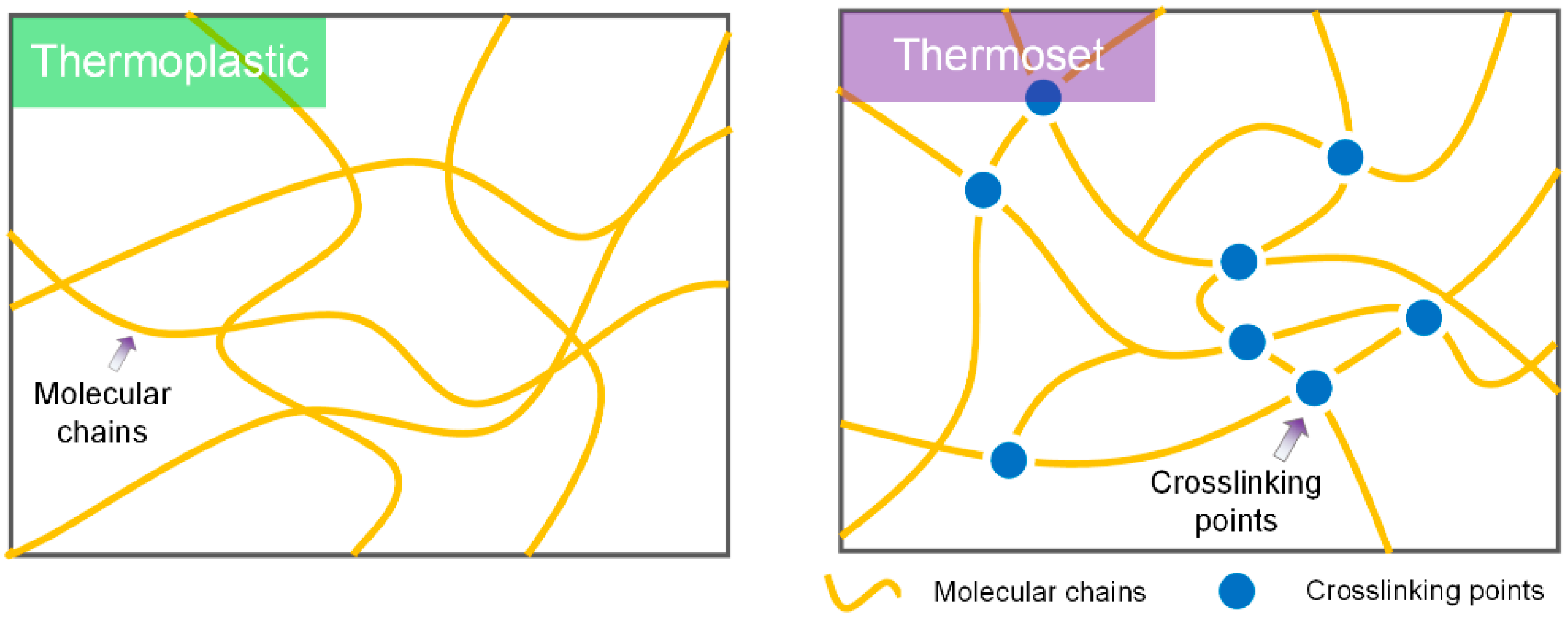


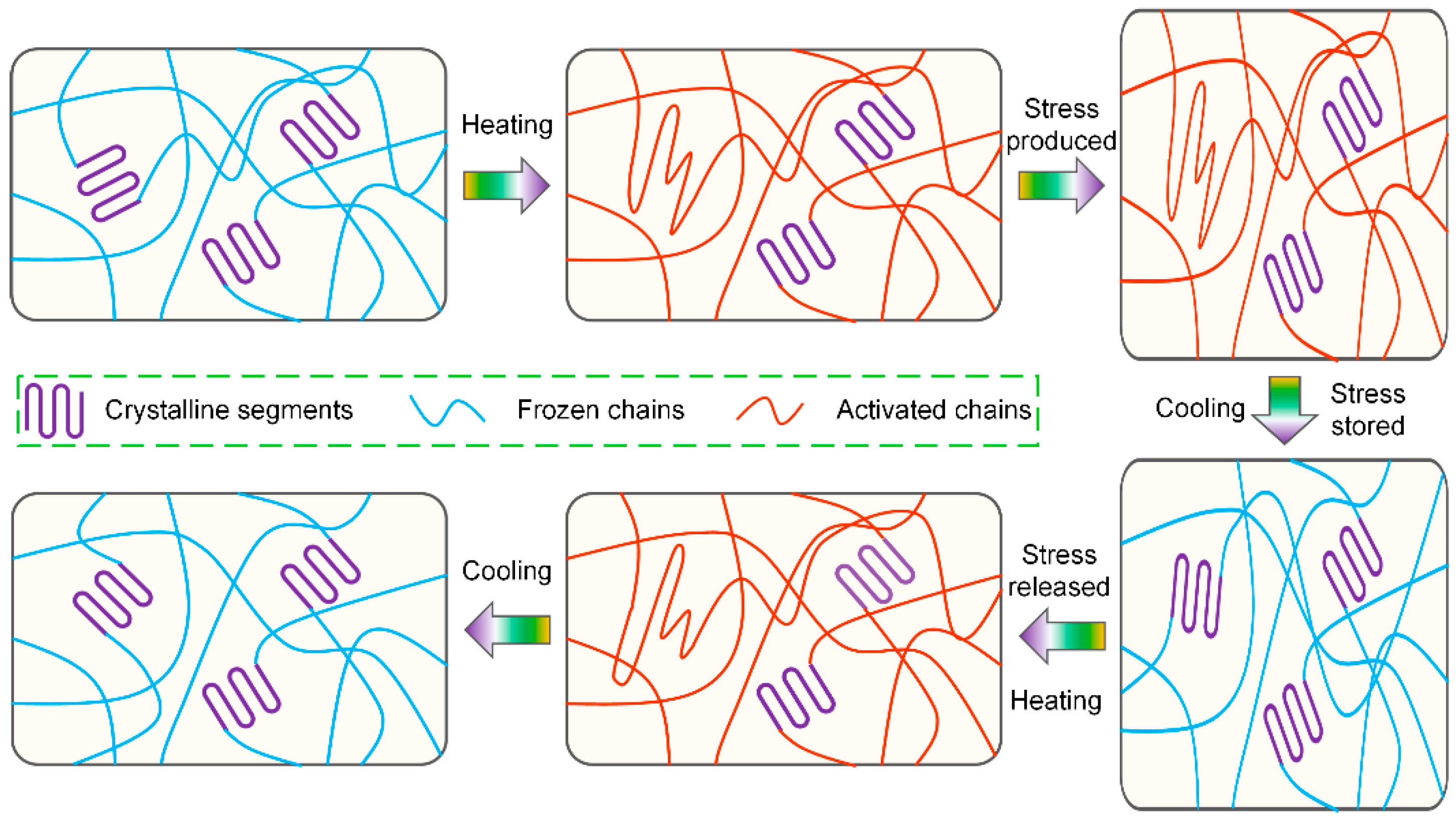
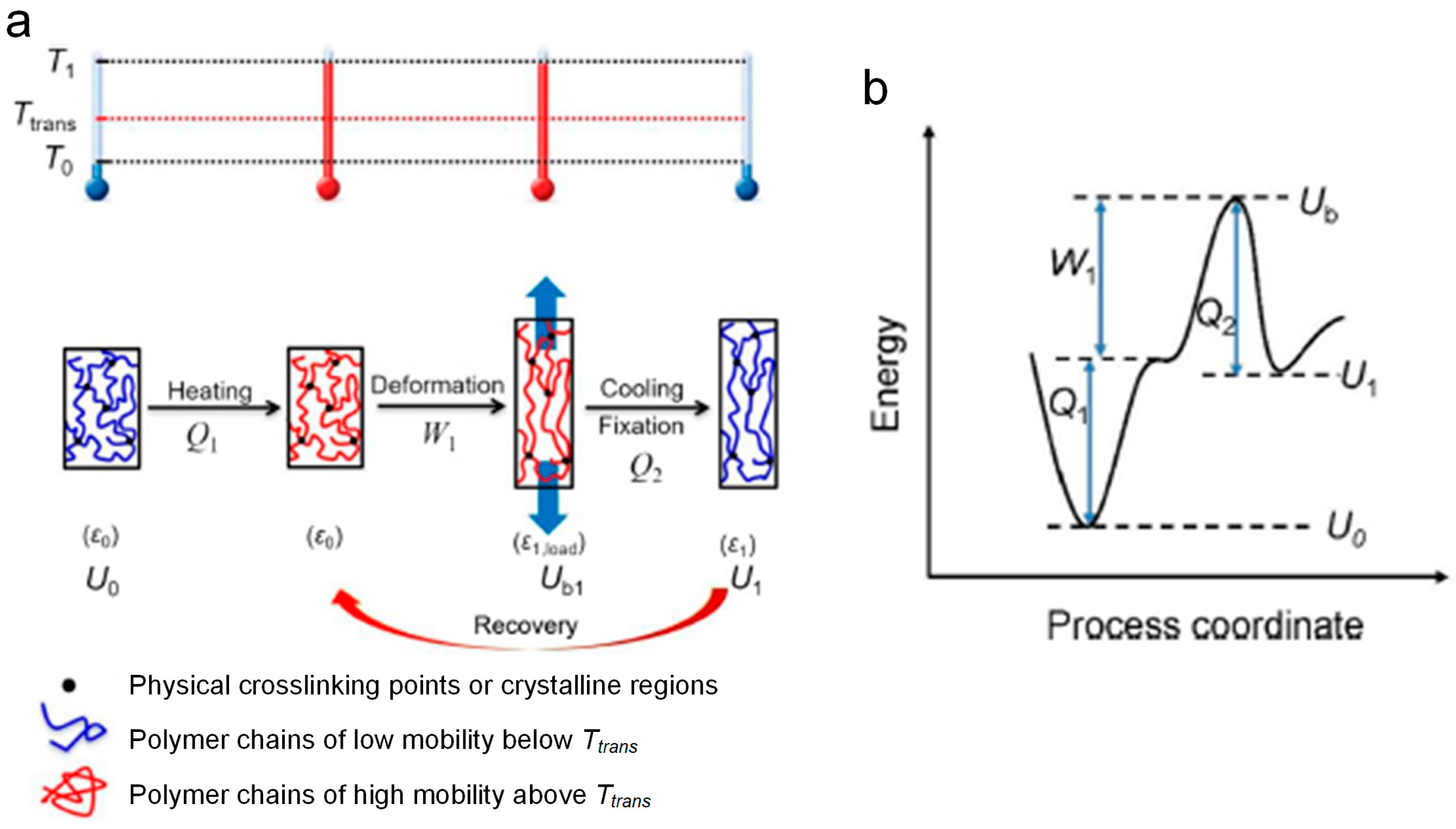
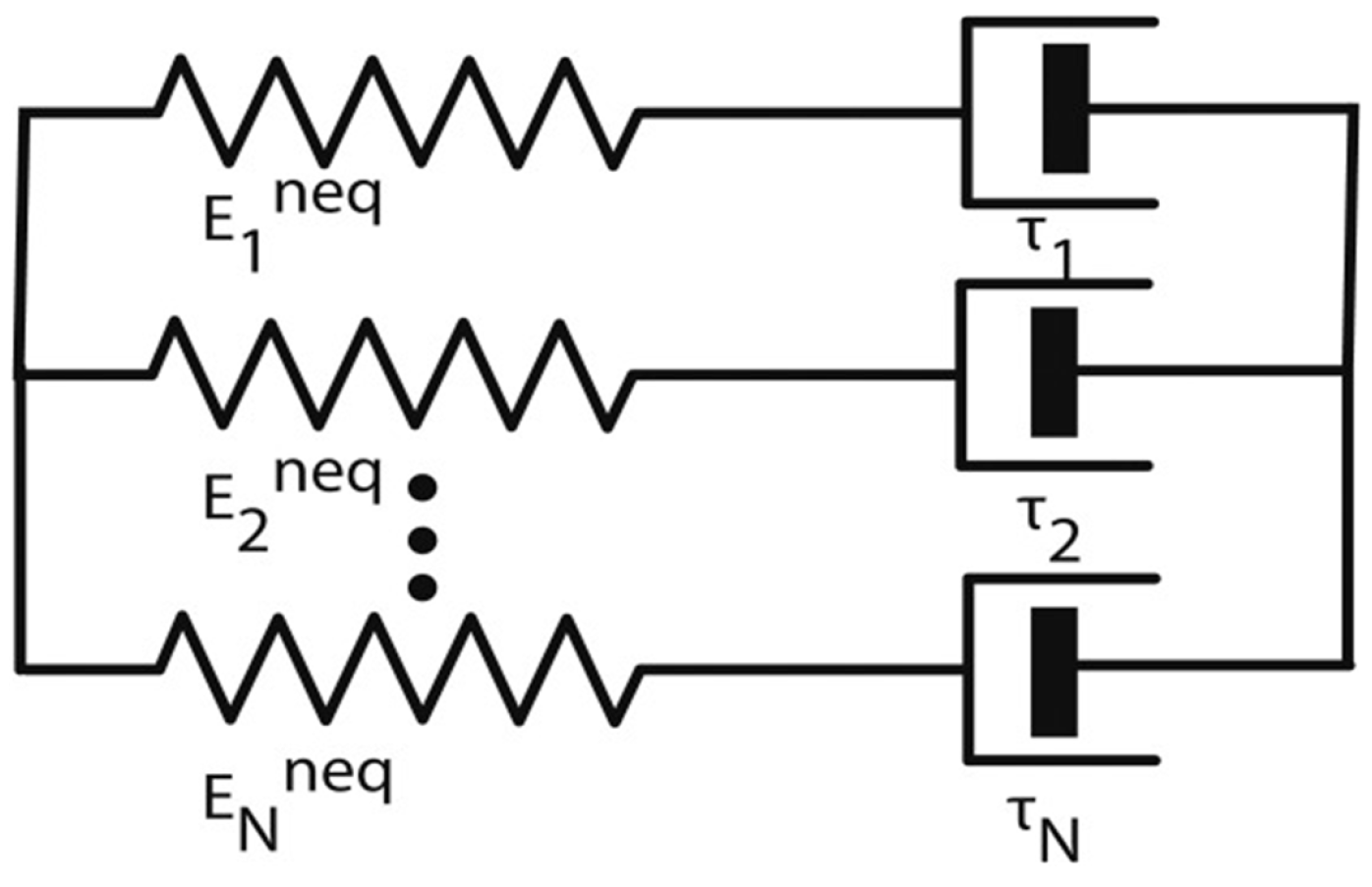
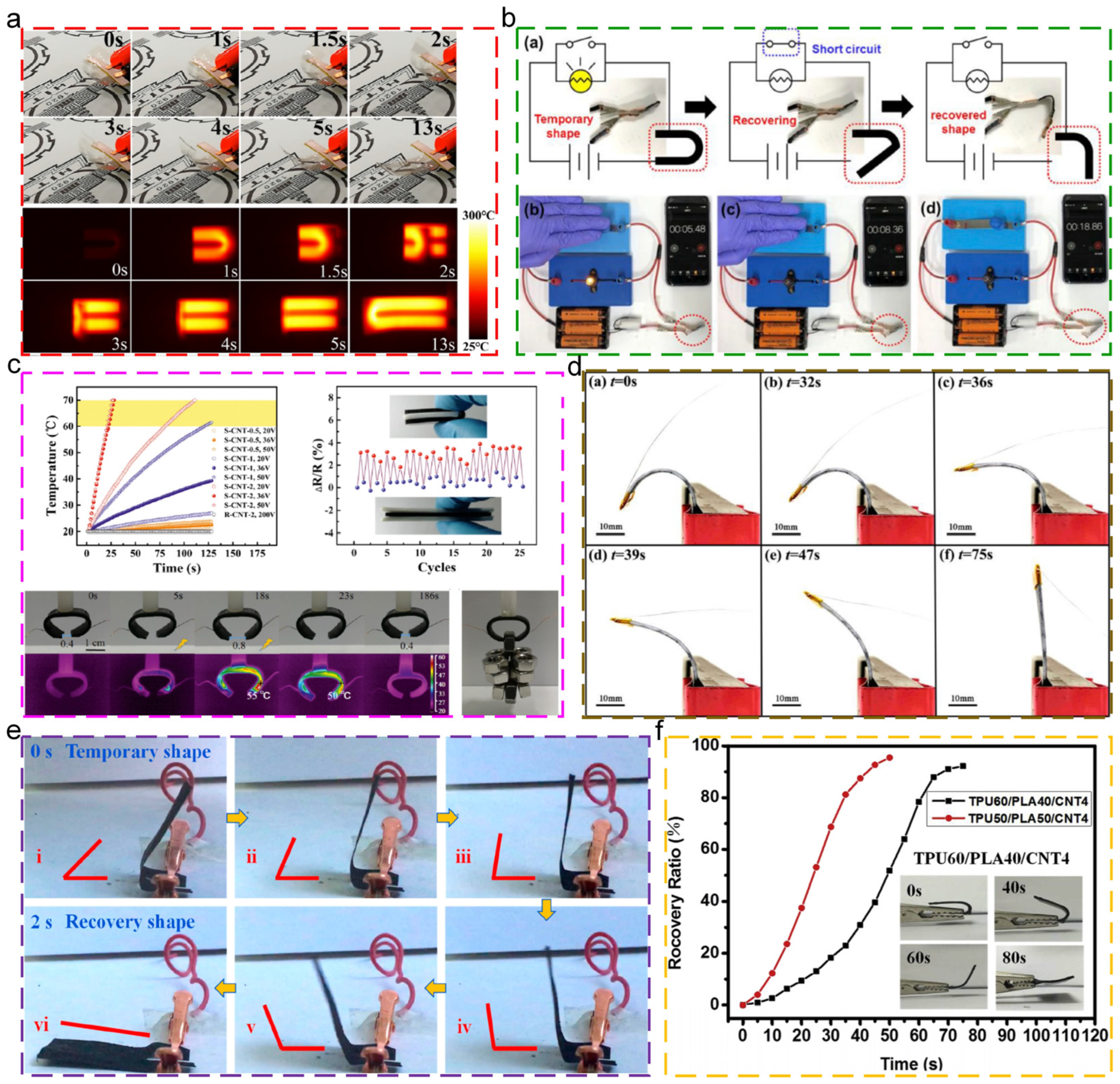


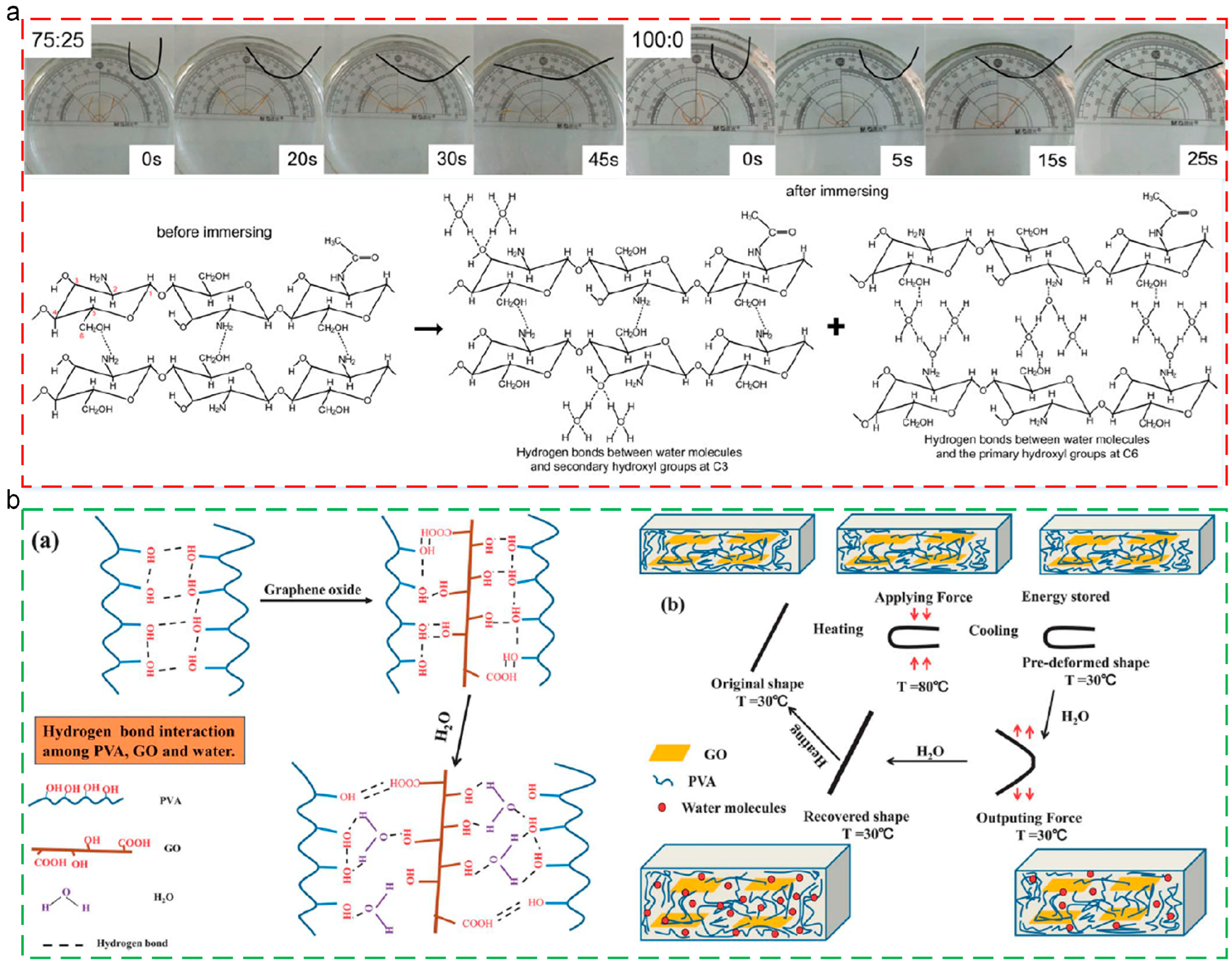


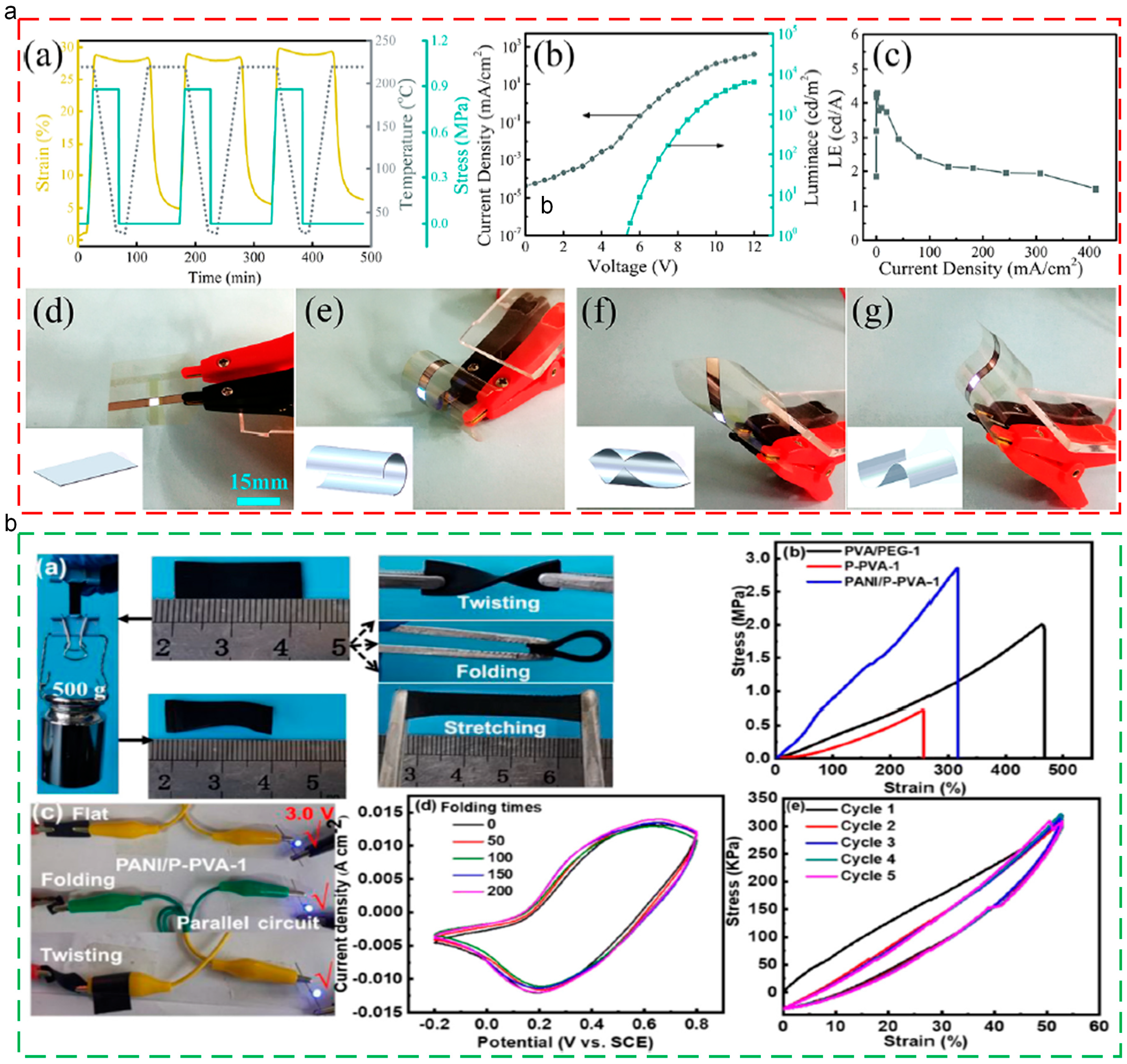

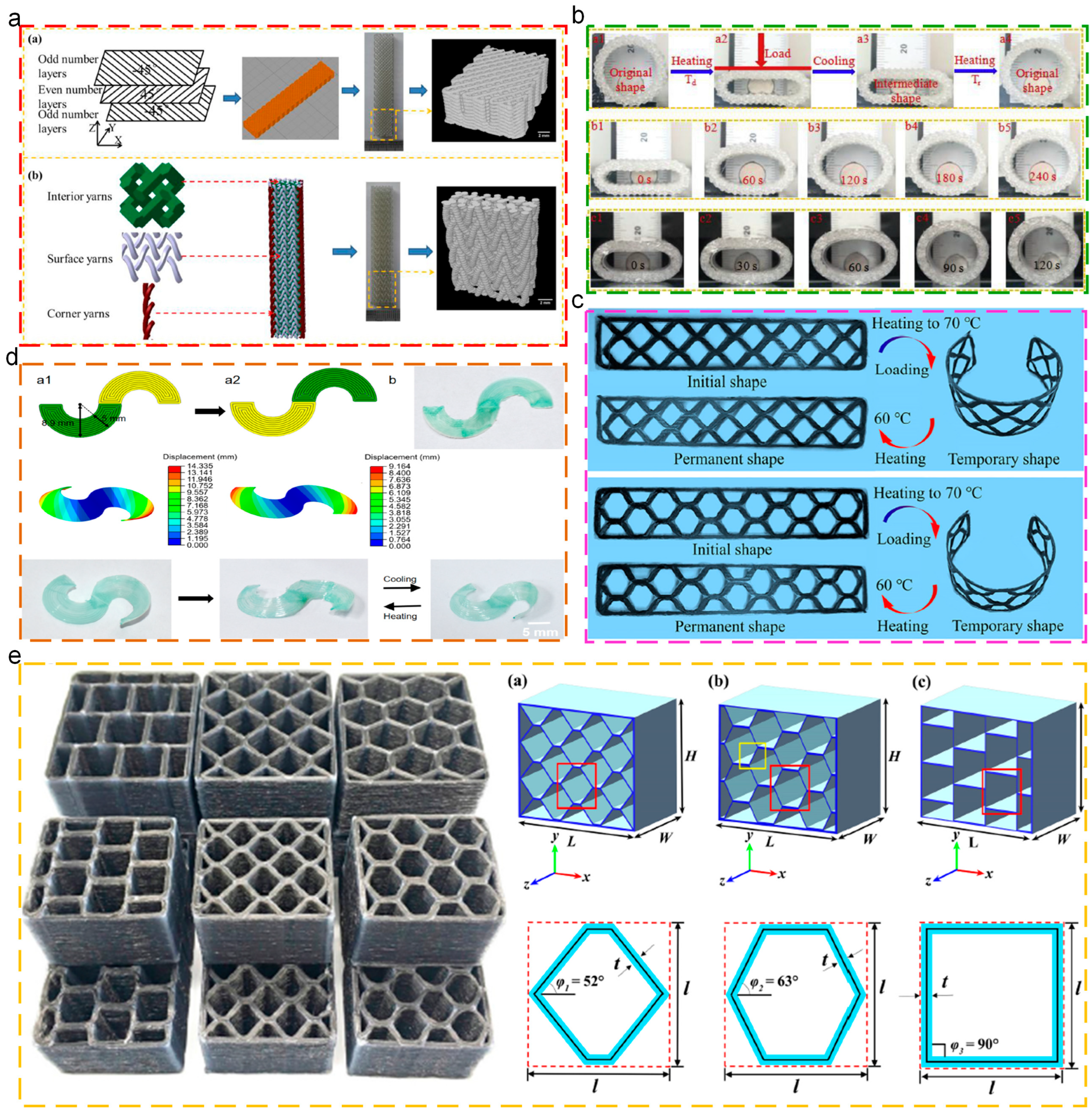
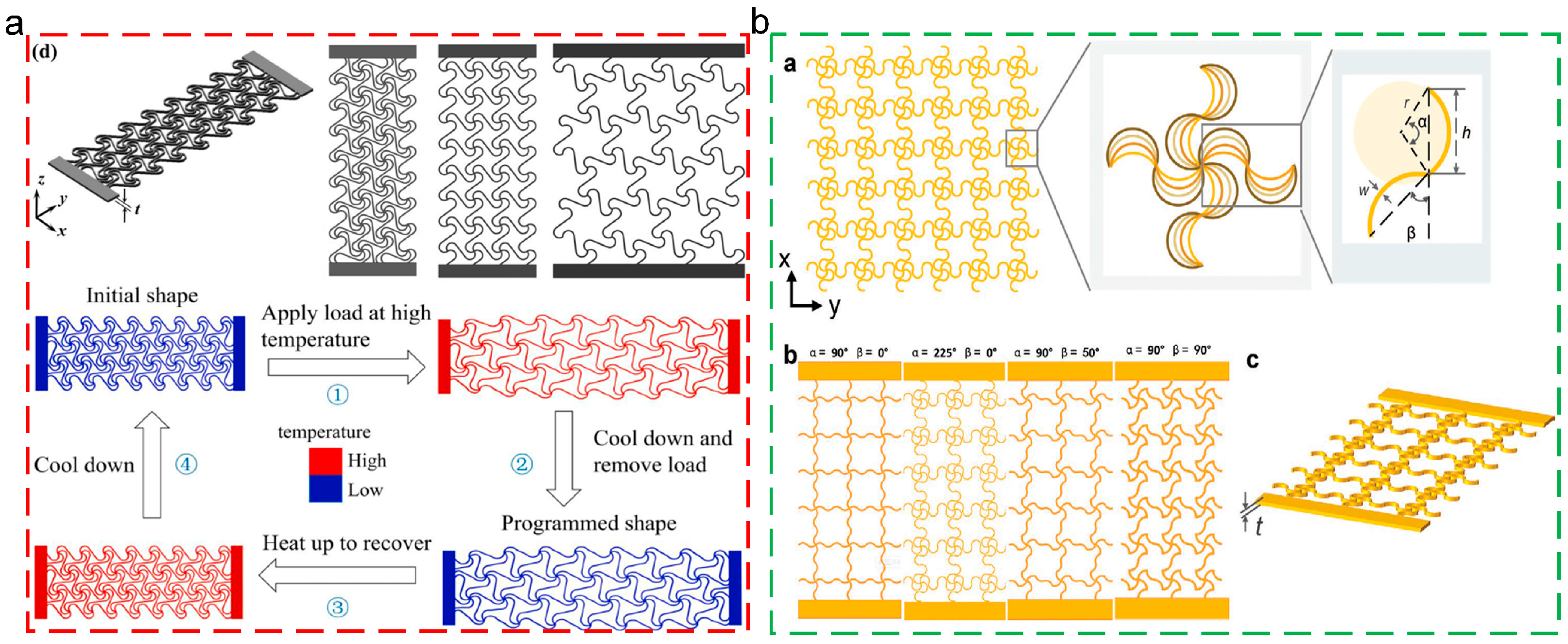
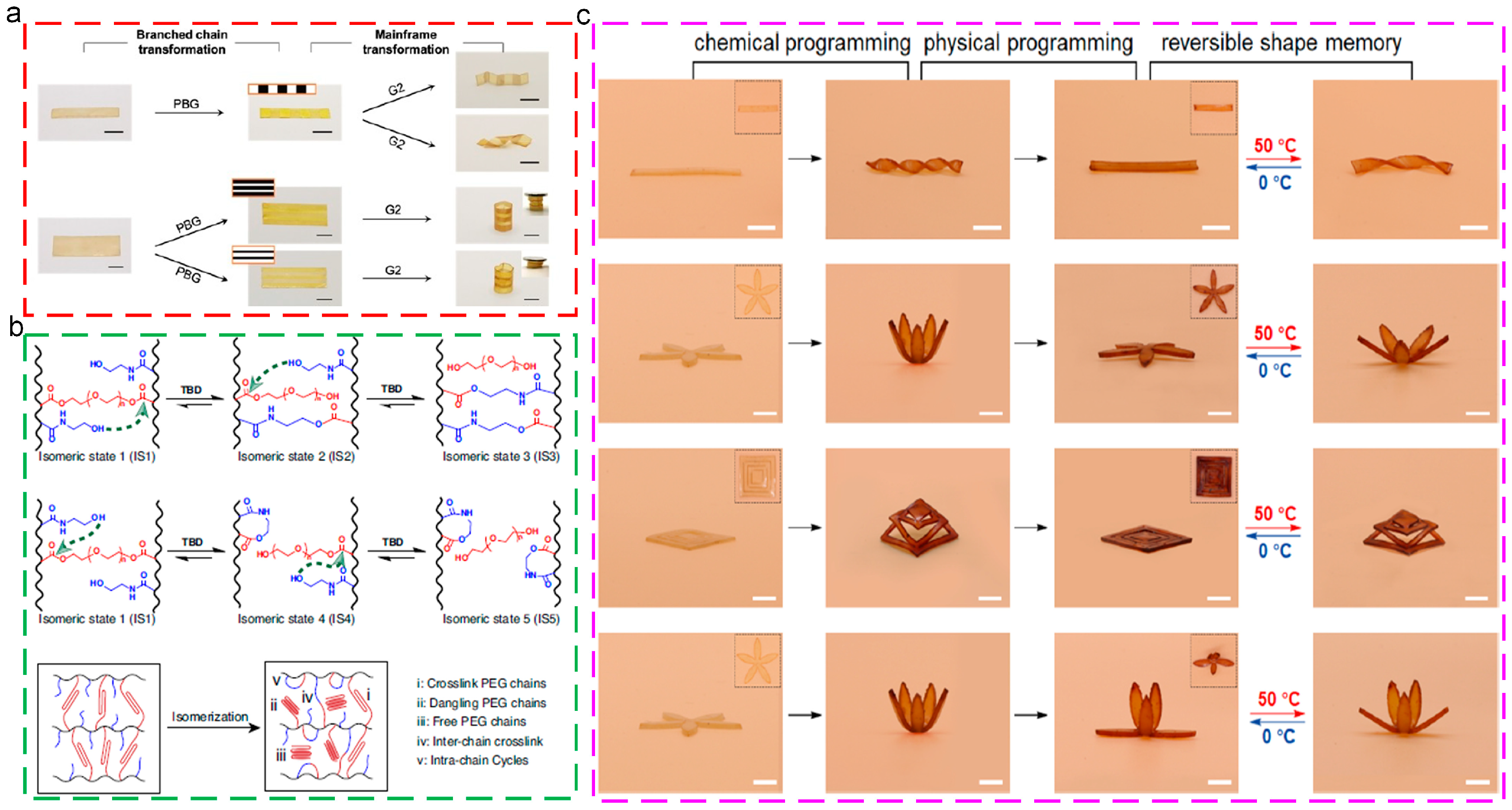
| Material | Transition Temperature (°C) | Feature | Application | |
|---|---|---|---|---|
| Polylactic acid (PLA) |  | 55−65 | High strength, biocompatibility | Biomedical stents [45,46,47,48] |
| Polyurethane (PU) |  | 25−50 | Body temperature actuation | Biomedical applications [49,50,51,52,53,54] |
| Polycaprolactone (PCL) | 50–70 | Functionality | Actuators [55,56,57,58] | |
 | ||||
| Polyimide (PI) | 220–250 | Heat resistance | Engineering applications [59,60,61,62,63,64,65] | |
 | ||||
| Polyvinyl alcohol (PVA) |  | 75−85 | Water actuation | Actuators [66,67,68,69,70,71] |
| Polyolefin (PO) |  | 50−80 | Low cost | Composite materials [72,73,74,75,76] |
| Polystyrene (PS) |  | 80−100 | High strength | Composite materials [77,78,79] |
| Polynorbornene (PNBE) |  | 40−50 | Deformation ability | Smart materials [80,81,82,83] |
| Ethylene vinyl acetate copolymer (EVA) | 60–80 | Humidity response | Biomedical applications [84,85,86] | |
 | ||||
| Poly(aryl ether ketone) (PAEK) | 130–150 | Thermal stability | Aerospace applications [87,88,89,90,91,92] | |
 | ||||
| Poly(methyl methacrylate) (PMMA) |  | 90−100 | Optical transparent | Optical devices [93,94,95,96,97] |
| Chitosan (CS) | 140–160 | Biocompatibility | Biomedical applications [98,99,100] | |
 | ||||
Disclaimer/Publisher’s Note: The statements, opinions and data contained in all publications are solely those of the individual author(s) and contributor(s) and not of MDPI and/or the editor(s). MDPI and/or the editor(s) disclaim responsibility for any injury to people or property resulting from any ideas, methods, instructions or products referred to in the content. |
© 2025 by the authors. Licensee MDPI, Basel, Switzerland. This article is an open access article distributed under the terms and conditions of the Creative Commons Attribution (CC BY) license (https://creativecommons.org/licenses/by/4.0/).
Share and Cite
Yang, S.; He, Y.; Song, Z.; Li, Y. Research Status and Potential Direction for Thermoplastic Shape Memory Polymers and Composites: A Review. Polymers 2025, 17, 1360. https://doi.org/10.3390/polym17101360
Yang S, He Y, Song Z, Li Y. Research Status and Potential Direction for Thermoplastic Shape Memory Polymers and Composites: A Review. Polymers. 2025; 17(10):1360. https://doi.org/10.3390/polym17101360
Chicago/Turabian StyleYang, Shuai, Yang He, Zijian Song, and Yingchun Li. 2025. "Research Status and Potential Direction for Thermoplastic Shape Memory Polymers and Composites: A Review" Polymers 17, no. 10: 1360. https://doi.org/10.3390/polym17101360
APA StyleYang, S., He, Y., Song, Z., & Li, Y. (2025). Research Status and Potential Direction for Thermoplastic Shape Memory Polymers and Composites: A Review. Polymers, 17(10), 1360. https://doi.org/10.3390/polym17101360







